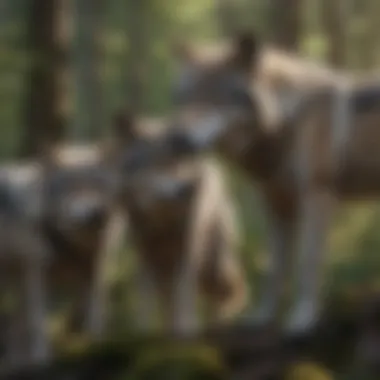Unveiling the Top 10 Intriguing Facts About Wolves: A Dive into Nature's Iconic Predators


Nature Topic Overview
Wolves, one of nature's most fascinating and iconic predators, have captivated human imagination for centuries. Their complex social structures and remarkable hunting skills make them truly intriguing creatures to study. In this article, we will delve into the world of wolves, unveiling top 10 fascinating facts that shed light on their behaviors and interactions within their ecosystem.
Fun Facts and Trivia
- Social Dynamics: Wolves are highly social animals, living in packs led by an alpha pair. These packs exhibit intricate hierarchies and communication systems, with each member playing a vital role in the group's survival.
- Hunting Prowess: Wolves are skilled hunters, relying on teamwork and coordinated tactics to take down prey much larger than themselves. Their hunting strategies and stamina are awe-inspiring.
Wildlife Explorations
Exploring wolves also involves understanding related species within their habitat. From coyotes to foxes, these animals share ecosystems with wolves and contribute to the biodiversity of the region. Learning about the interactions between these species can provide further insights into the delicate balance of nature.
Environmental Awareness
Conservation efforts play a crucial role in protecting wolves and their habitat. Understanding the importance of maintaining healthy ecosystems and promoting sustainable practices is key to safeguarding these majestic predators for future generations. Parents can educate children on wildlife conservation and how they can actively contribute to preserving nature's diversity.
DIY Nature Activities
Engaging children in hands-on activities related to wolves can spark their curiosity and appreciation for the environment. From creating wolf-themed crafts to organizing nature walks focusing on wildlife observation, there are myriad ways to inspire young minds and encourage a love for the natural world.
Introduction
Wolves are among the most intriguing creatures in the natural world, captivating the minds of many due to their complex social structures and exceptional hunting abilities. In this exploration of the top 10 fascinating facts about wolves, we delve into the depths of their world, unraveling remarkable insights that showcase the uniqueness of these iconic predators. Understanding wolves goes beyond fascination; it offers a glimpse into the delicate balance of ecosystems and the interconnectedness of all living beings. As we navigate through the intricacies of wolf behavior and significance, we are presented with a tapestry of knowledge that fuels our curiosity and appreciation for the natural world.
In our journey through this article, we will uncover the mysteries surrounding wolves, shedding light on their social dynamics, hunting prowess, and vital role in maintaining ecological stability. Each fact we unearth will paint a vivid picture of the resilience and intelligence that define these majestic creatures. Join us in unraveling the enigma of wolves, as we navigate through their world with a sense of wonder and respect for the wonders of nature.
Wolves Are Highly Social Creatures
Exploring the realm of wolves reveals a captivating insight into their intricate social structures, emphasizing the essence of camaraderie within wolf packs. Unraveling the enigma of these majestic creatures, one begins to appreciate the profound significance of their interactions. Wolves are not solitary beings but thrive in cohesive units known as packs, fostering a sense of belonging and cooperation that underpins their survival in the wilderness.
Pack Structure
Diving into the nuances of wolf pack dynamics sheds light on the hierarchy and organization within these tightly-knit groups. Packs are often led by an alpha pair who exhibit dominance and responsibility in decision-making processes. Moreover, each pack member plays a vital role, contributing uniquely to the group's cohesion and functioning. The intricate balance of power and cooperation within the pack showcases the collaborative nature of wolves, illustrating how their social structure is finely tuned for optimum efficiency and success.


Communication Within Packs
Communication lies at the heart of wolf pack interactions, underscoring the importance of effective information exchange in their daily lives. Wolves employ a variety of vocalizations, body language, and scent marking to convey messages within the pack. From howls that echo through the forest to subtle postures that signify submission or dominance, wolves rely on a sophisticated communication system to maintain order and unity within the group. This intricate language of the wild showcases the depth of understanding and connection present among pack members, highlighting the remarkable ways in which wolves express themselves and bond with one another.
2. Their Howl Serves Various Purposes
In the intricate world of wolves, their howl serves as a multifaceted tool crucial for survival and communication within the pack. This poignant vocalization holds significant importance in maintaining social cohesion, establishing territory, and signaling vital information across distances.
2. Establishing Territory
A distinctive aspect of wolf behavior is using their howl to demarcate boundaries and assert dominance over a particular area. When a wolf pack howls together in harmony, it sends a powerful message to potential intruders, warning them to stay away from their claimed territory. This primal form of communication helps prevent conflicts with rival packs and maintains order within the ecosystem. The strategic orchestration of their howls reflects a sophisticated understanding of spatial awareness and territoriality essential for their survival.
2. Signaling Location
Beyond delineating territorial limits, wolves utilize their howls to communicate and coordinate with pack members over vast distances. By varying the pitch, frequency, and duration of their howls, wolves can convey specific messages regarding their location, potential threats, and the availability of food sources. This nuanced form of communication enables wolves to navigate expansive landscapes efficiently, reunite with separated pack members, and synchronize their hunting strategies for maximum effectiveness. The intricate communication network facilitated by their howls showcases the remarkable adaptability and intelligence of these majestic creatures.
3. Wolves Have Remarkable Hunting Skills
In this section, we shine a light on the critical skillset of wolves that sets them apart as apex predators. Wolves' hunting prowess is not just about securing a meal; it plays a vital role in maintaining the balance of ecosystems. Their hunting skills are finely tuned over centuries of evolution, making them efficient and strategic hunters.
3. Hunting Strategies
Wolves employ a variety of hunting strategies that showcase their intelligence and adaptability. From coordinated group hunts to solitary pursuits, wolves exhibit remarkable teamwork and communication. Their strategic approach involves encircling and outmaneuvering prey, demonstrating a deep understanding of pack dynamics and individual roles within the hunt.
3. Adaptations for Hunting
Adapted perfectly to their hunting environment, wolves possess physical characteristics that aid in successful hunts. Sharp teeth and strong jaws allow them to take down prey swiftly and efficiently. Their keen senses of smell and hearing give them an advantage in tracking and locating potential targets, ensuring their prowess as top predators in their habitats.
4. They Play an Essential Role in Ecosystems
In the intricate web of ecosystems, wolves hold a crucial position, showcasing a delicate balance that reverberates throughout the natural world. Their presence bears significant implications on various facets of the environment, illustrating the interconnectedness of all living beings in the wild.
4. Impact on Prey Populations


Wolves, as apex predators, play a pivotal role in regulating prey populations within their habitats. By preying upon herbivores, they help control the numbers of these animals, preventing overgrazing that can degrade vegetation and disrupt the ecological equilibrium. This predatory behavior exerts a top-down influence on the ecosystem, shaping the abundance and distribution of prey species and influencing the overall biodiversity of the region.
4. Trophic Cascade Effects
Furthermore, the effects of wolves extend beyond direct predation, triggering what is known as a trophic cascade. As wolves limit the population of herbivores, the vegetation in the area experiences relief from intense browsing pressure. This, in turn, leads to the regeneration and diversification of plant species, ultimately enhancing habitat quality for a myriad of other organisms. The intricate connection between wolves, prey, and vegetation exemplifies the far-reaching consequences of predator-prey interactions in shaping the dynamics of ecosystems.
5. Wolves Possess Exceptional Survival Instincts
Wolves are revered for their exceptional survival instincts, crucial for thriving in diverse environments. This section delves deep into the significance of wolves' survival skills within the broader context of this article, shedding light on the specific elements that enable these apex predators to endure and flourish. Understanding the intricacies of wolves' survival instincts is paramount to appreciating their role in the ecosystem and their ability to adapt to challenges they face. By showcasing the remarkable attributes that contribute to wolves' survival prowess, such as their keen sense of smell and acute hearing, this section elevates the reader's comprehension of these majestic creatures' essential traits.
5. Sense of Smell and Hearing
Wolves possess a heightened sense of smell and acute hearing, essential tools that aid in their survival and hunting endeavors. Their olfactory capabilities are extraordinary, allowing them to detect scents over long distances and navigate their surroundings with precision. Moreover, wolves' acute hearing enables them to perceive subtle sounds, from the rustling of prey to distant howls of pack members, enhancing their awareness of the environment. By honing in on the exceptional sense of smell and hearing that wolves possess, this subsection underscores how these sensory adaptations are integral to their survival strategy, shaping their behavior and interactions within the ecosystem.
5. Intelligence and Problem-Solving Skills
Apart from their sensory acuity, wolves exhibit remarkable intelligence and problem-solving skills that contribute to their survival in the wild. Their ability to assess situations, adapt strategies, and communicate effectively within the pack showcases their high cognitive capacity. Wolves employ complex social structures and cooperation to overcome challenges, demonstrating a level of intelligence that is essential for their collective survival. By exploring the intelligence and problem-solving skills of wolves, this section highlights the nuanced behaviors and cognitive abilities that underpin their successful navigation of the natural world, enriching our understanding of these fascinating predators.
6. The History of Humans and Wolves Interactions
Wolves have a rich history of interactions with humans, dating back centuries. Exploring this historical relationship provides valuable insights into how these majestic animals have influenced human culture and society. From ancient folklore and mythology to modern conservation efforts, the bond between humans and wolves transcends time and carries significant cultural relevance.
6. Cultural Significance
The cultural significance of wolves in human history is profound. Across various civilizations, wolves have held diverse symbolisms ranging from guardianship and wisdom to fear and destruction. In Native American folklore, wolves are revered as spiritual guides and teachers, embodying strength and loyalty. In Norse mythology, the wolf Fenrir represents chaos and destruction, showcasing the multifaceted beliefs surrounding these enigmatic creatures. Understanding these cultural interpretations sheds light on the deep-rooted connections between humans and wolves.
6. Conservation Efforts
Conservation efforts aimed at protecting wolf populations highlight the growing awareness of their ecological importance. Through habitat preservation, reintroduction programs, and public education, conservationists strive to safeguard these apex predators from extinction. The intricate balance between human activities and wolf conservation poses significant challenges, requiring concerted efforts to mitigate conflicts and promote coexistence. Advocating for the conservation of wolf species is crucial not only for preserving biodiversity but also for maintaining the delicate equilibrium of ecosystems worldwide.
7. Acknowledging the Diversity of Wolf Species
In the vast realm of wildlife, the acknowledgment of the diverse species of wolves holds significant relevance as it unravels the intricate tapestry of nature's creations. Understanding the various types of wolves not only enriches our knowledge but also sheds light on the evolutionary paths these majestic creatures have traversed. The diversity among wolf species encompasses variations in physical attributes, behavioral patterns, and habitat preferences, portraying a nuanced ecosystem where each type plays a unique role. By delving into the distinctive characteristics of different wolf species, we gain a profound appreciation for the adaptability and resilience that have sustained their existence through the ages.


7. Different Types of Wolves
Exploring the different types of wolves unveils a mesmerizing array of adaptations and features specific to each subspecies. From the Arctic-dwelling Arctic wolf with its thick fur and snow-white coat to the formidable Eastern Wolf found in the forests of eastern Canada, each type showcases specialized traits honed for survival in diverse environments. The iconic Gray Wolf, known for its widespread distribution across various continents, exhibits variations in size and coloration based on geographical location. Additionally, the critically endangered Red Wolf serves as a poignant reminder of the conservation challenges faced by some wolf species due to human encroachment and habitat loss.
7. Distribution Across Regions
The distribution of wolf species across different regions offers a glimpse into the dynamic interplay between geography, climate, and ecosystems. Wolves have adapted to thrive in a range of habitats, from the rugged mountains of North America to the vast forests of Eurasia. The Gray Wolf, known for its adaptability, has established populations in diverse terrains, including tundra, grasslands, and deserts. Understanding the distribution patterns of wolf species not only elucidates their ecological requirements but also highlights the interconnectedness of ecosystems on a global scale. By exploring the regions where wolves roam, we gain insights into the challenges they face amidst shifting landscapes and human-induced pressures.
8. Wolves in Pop Culture and Folklore
Within the vast realm of human culture and folklore, wolves have played a significant role, permeating various facets of society and belief systems. Their presence in pop culture and folklore transcends time and borders, capturing the imagination of people across generations.
Exploring the representation of wolves in different cultural contexts unveils a tapestry of symbolism deeply rooted in myths, legends, and spiritual beliefs. In some cultures, wolves symbolize strength, loyalty, and courage, revered as noble creatures embodying the wild spirit of nature. Conversely, other societies view wolves as symbols of darkness, trickery, and danger, often portraying them as cunning adversaries in folk tales and fables.
The depiction of wolves in literature and media reflects their multifaceted nature, showcasing them as mysterious and complex beings navigating the delicate balance between instinct and intellect. From classic fables like
9. The Threats Facing Wolf Populations
Wolves, majestic creatures that have captivated human imagination for centuries, face a myriad of threats in the modern world. Understanding these threats is crucial for the conservation and preservation of wolf populations globally. The intricate balance between human activities and wolf habitats is delicate and requires careful consideration to ensure the survival of these iconic predators.
9. Habitat Loss and Fragmentation
Habitat loss and fragmentation pose significant challenges to wolf populations around the world. As human civilization expands, wild areas suitable for wolves diminish, leading to the fragmentation of their habitats. This fragmentation undermines the ability of wolf packs to find sufficient prey and raises the risk of inbreeding. The disruptive effects of habitat loss can also result in increased human-wolf encounters, heightening conflicts and endangering both wolves and people. Conservation efforts must focus on preserving vast, interconnected swathes of wilderness to mitigate the impact of habitat loss and fragmentation on wolf populations.
9. Human-Wolf Conflict
Human-wolf conflict represents a critical threat to the coexistence of these two species. Encroachment upon wolf territories by human settlements often leads to confrontations as wolves struggle to adapt to rapidly changing environments. Livestock depredation by wolves poses a significant challenge for farmers, leading to retaliatory killings and persecution of wolves. Managing human-wolf conflicts requires a multi-faceted approach that includes community engagement, implementation of non-lethal deterrents, and fostering mutual understanding between stakeholders. By addressing the root causes of conflict and promoting tolerance towards wolves, we can strive towards peaceful cohabitation between humans and these magnificent creatures.
10. Conclusion
In reflecting on the wealth of information presented throughout this comprehensive article on the top 10 fascinating facts about wolves, it becomes evident that these majestic creatures hold a vital position within our ecosystems and collective understanding of wildlife dynamics. The conclusion serves as a synthesis of the key insights garnered from exploring various facets of wolf behavior, ecology, and interactions with humans.
Through uncovering the social dynamics of wolf packs, from intricate hierarchies to fascinating modes of communication, we have gained a profound appreciation for their highly evolved and intelligent nature. These insights shed light on how wolves function as highly social and cooperative beings, emphasizing the importance of unity and collaboration in their quest for survival and prosperity.
Furthermore, delving into the remarkable hunting skills possessed by wolves has showcased their crucial role in maintaining ecological balance. Their hunting strategies, honed over centuries of evolution, highlight their adaptability and efficiency as top predators, shaping prey populations and influencing entire ecosystems through trophic cascade effects.
In considering the threats facing wolf populations today, including habitat loss and human-wolf conflict, it is imperative to acknowledge the delicate balance required for coexistence between humans and these iconic carnivores. Conservation efforts and increased awareness are essential for mitigating these challenges and ensuring the survival of wolf species across different regions.
Moreover, the historical and cultural significance of wolves underscores their enduring presence in human folklore and symbolism. Representations of wolves in literature and media offer a lens through which we explore our complex relationship with these creatures, showcasing the blend of fear, admiration, and respect they evoke in various cultures worldwide.
As we conclude this exploration of wolf facts, it is evident that these animals encapsulate a tapestry of traits that make them both fearsome predators and essential components of our natural world. From their exceptional survival instincts to their enigmatic howling rituals, wolves continue to captivate our imaginations and challenge us to rethink our role in preserving the diversity and richness of our planet's biodiversity.







